Story by Chris Hector and Photos by Roslyn Neave and Barbara Schnell
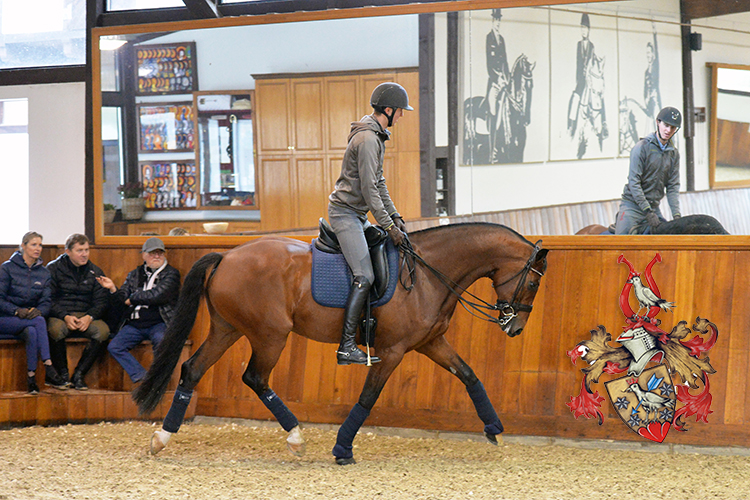
Three fifths of the Rothenbergers – Gonnelien, Sven and Sönke talk to Chris Hector at Gestüt Erlenhof
A visit to the family Rothenberger is a stimulating experience on about half a dozen levels. Just walking around the magnificent Gestüt Erlenhof is quite thrilling – this is one of Germany’s great historic stud farms. Founded in 1901, the stud was home to some of Germany’s most famous Thoroughbred stallions, now the historic stables are occupied by some of Europe’s most famous dressage horses, the ones ridden by the current generation of Rothenberger dressage stars: Sanneke, Sönke and Semmieke.
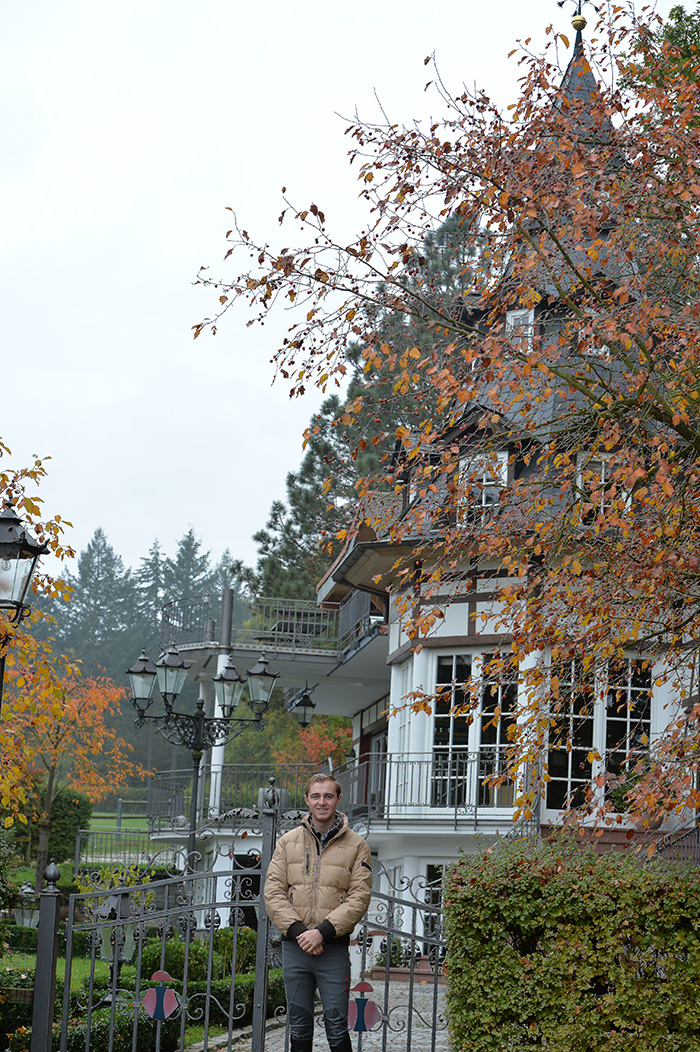
Our guide as we tour the beautifully tended grounds is Sönke, recently returned from his gold medal winning performance in Rio. Sönke obviously has a very strong personal bond with his horses, and they are delighted to see him…
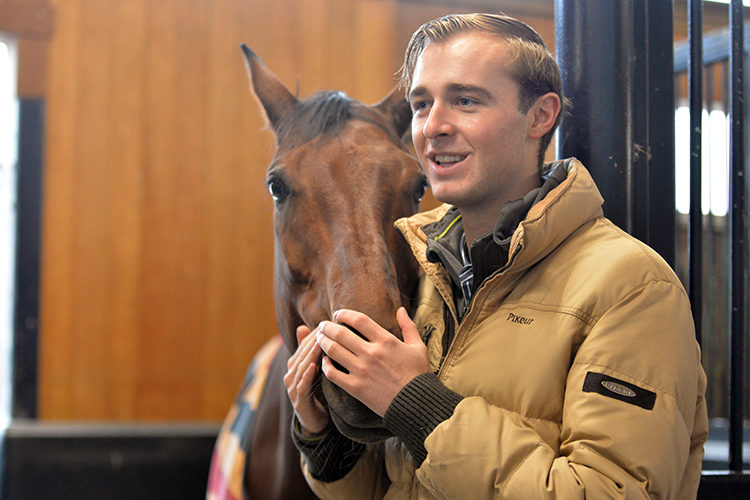
Back in the indoor, Sönke’s mother, Gonnelien is in full flight, teaching. Gonnelien was always one of the most glamorous riders to grace the international dressage circuit, and she is one of those women who get even more beautiful as time goes bye.
By the time we get back from our tour, Sven is in the arena with his current project Hilary (well it could have been worse, like ‘Donald’).
“He always wants the difficult ones,” says Gonnelien, “when he started with her, she was really wild. I think with the modern bred horses, they need this sort of work on the ground, they need the time. Also they need to be worked not just once a day, horses are not made to stay in an area three by four square metres, half a day she is out where she can see other horses. I think it is very important for their heads that horses can be horses. The horses are lucky when they come to our place…”
“It’s not just the riding, we try to work with very good people like Linda Tellington and Andreas Hausberger from the Spanish School, to help with the piaffe work. We learn, we learn – you are never too old to learn.”
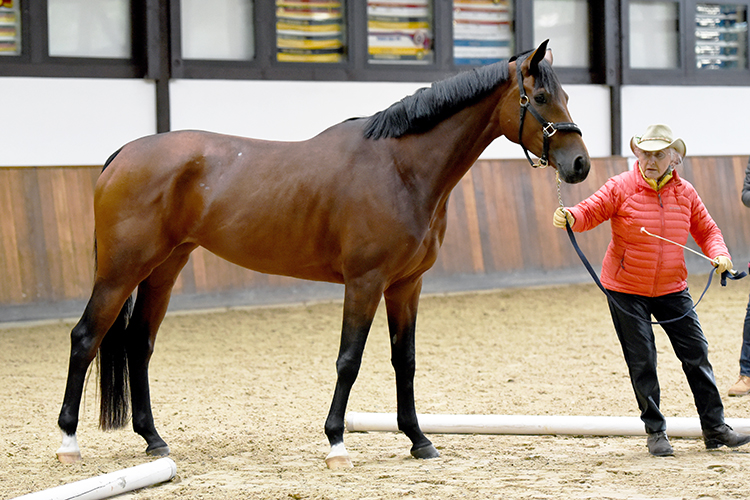
Linda Tellington working with Hilary
You were saying this mare used to rear when you got her?
“We bought her at an auction, everybody there saw her movement, she is great but she is difficult, she would go up. Some people didn’t want her because she is a mare, but we like mares. Her breeding is Florencio / Jazz.”
Nice and hot…
“Exactly, nice and hot, but I think this is what you need later for the Grand Prix. We don’t know yet whether we will get her on our side. When we got her, it was not possible for her to lower her head, and we’ve learnt that when a horse puts its head down, it feels confident. Look at a horse in the field, when it hears something, the head goes up and they run away – and that’s what she did. Now she is totally with Sven…”
At this point Sönke joins the conversation: “My father went to the Global Dressage Forum and Franke Sloothaak did a presentation on work in the double reins and my father was really happy and he told us he was delighted because he saw that what he was doing was the same as Franke. Now he’s practising all the professional stuff that he saw there, like changing the rein over the back.”
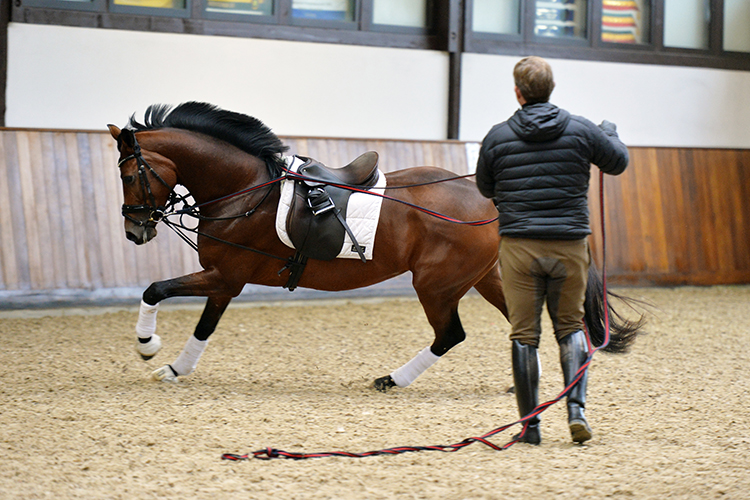
Sven and Hilary – double lunge reins
At this point Sven brings Hilary to a lovely square halt, and Gonnelien takes up her running commentary: “The most important thing is halt, and Sven is always looking at the feet to see that they are standing like this, square.”
“She is only four years old, so we have a lot to time, we don’t make pressure, and she is not going up any more! I think she is a great horse, but you can see it now, ask for canter and she is saying, oh god, now canter is coming.”
Sönke remarks that she is like his new horse: “She is like my young one, the one I am going to ride now, they give you a similar feeling, they are hot…”
But your one didn’t go up?
“Never, he would run backwards when he was scared. He was never against the rider, he just didn’t know what you wanted and he was scared. Hilary’s self defense was going up, my horse’s self defense was running backwards.”
Gonnelien as you can tell, is a real fan of work on the ground: “There is so much you can do from the ground when the horse is too tense with the rider in the saddle, it is stressful because of something that happened in the past. You can really get them listening to your voice, and then when you are riding them, you can use your voice to help them.”
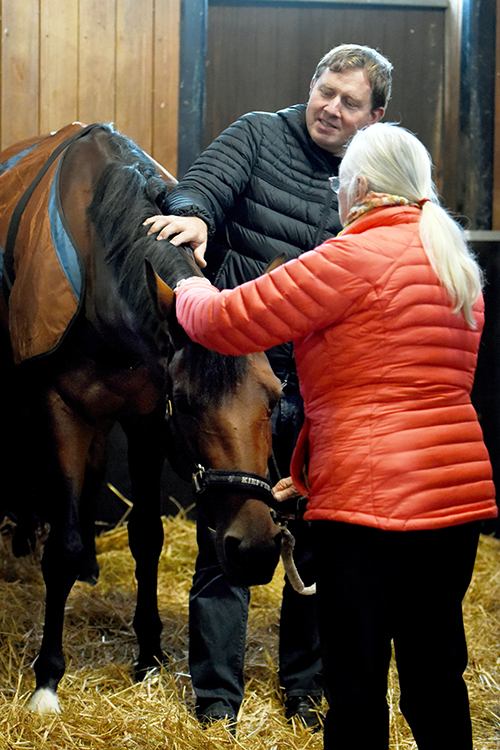
Linda demonstrates her technique and Hilary lowers her head
You have Linda Tellington-Jones come and help you…
“Once a year and we are really proud that she comes to our stable. Also we make videos and send them to her so she can see what we are doing and she comes up with suggestions, try this or try that. Now she is coming to Equitana in 2017 and perhaps she will do some exercises with Sammeke for all the visitors to see. She is 78 or 79 years old but she is top and she has such a nice sense of humor and she is moving on, she is not saying, okay, that’s what I did and keep doing it, she is changing, adding new things, she wants to go with the future.”
For more about Linda Tellington-Jones go to:
Teaching with Touch – Linda Tellington-Jones and the TEAM method
“I think more and more people are working from the ground, horses are not really made to be ridden, and if you always sit on the horse, it is not healthy. It is the same always riding in the small inside arena, 365 days a year… Think what can you do with your horse to give him a nice life that he wants to learn more. It’s like children, they like to do something different – jump a little with your dressage horses. In the winter when we have to work a lot inside, we make some poles on the ground and walk and trot and canter over them.”
“See now it is working with Hilary, her neck is longer now, this is how she should start.”
Sven is trying to get into the three way conversation, but it is a bit difficult out in the middle of the arena with a horse to take care of, but he is pointing out that the mare is not reacting to Roslyn and her camera: “She used to be afraid of human beings…”
Gonnelien makes the point, “look at her mouth now, look at the foam, she has not a dry mouth. We look at everything, we look at her tail, look at her ears. Is she confident? There are so many things when you are working with horses.”
“You can’t believe how afraid she was,” Sven says, “I couldn’t touch her, I couldn’t ride her, she was just going up in the air, running away. It is very important that the horses build up relationships with the human beings. That’s why I can’t stay in bed after six o’clock, because I know my horses are waiting for me.”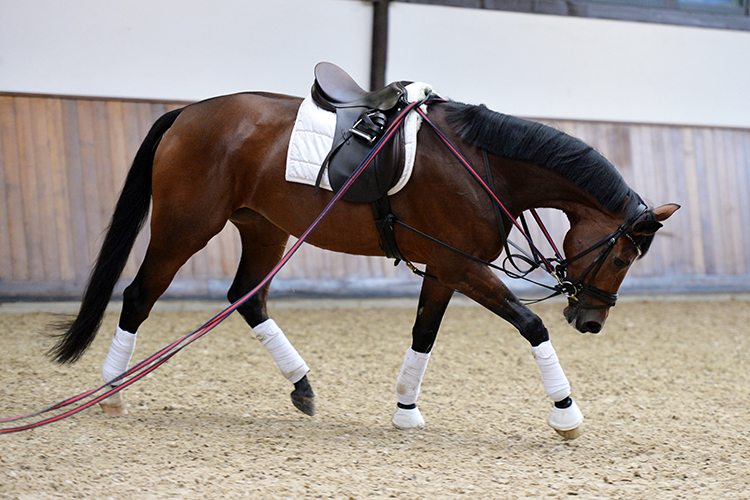
Back to Gonnelien: “this is not like a normal stable working in here the whole day long. Usually Sven is at work, making money for us to spend. Every child has two or three horses, Sven usually works with a couple of young horses, and we have pupils who come here to train. Our horses don’t know when it is Christmas or Easter, they are waiting for us. Four days for us is a big holiday. Rio was really special for us, we were so long away…”
It seems that at times the ultimate threat to the talented trio of Rothenberger children is a comeback by their parents….
“Sometimes they say, no Mum, or no Dad, we do it this way. And I say, okay I will show the horses myself – no, no you train me! Okay, but remember if you don’t listen, we go in the show ring again. No no don’t do this, you looked so good when you were young, now younger people look better.”
Right now, it’s Sönke who is in the indoor, riding Zgander by Blue Hors Zack out of a Florestan mare. Sönke talks about his new prospect: “He won the stallion licensing in Sweden with the highest points. Then he was in Denmark. He can be very very fresh, but he has a lot of potential and everywhere I take him I kind of like to show off, and I have a lot of people asking about him because he has so much expression, but he is also very sensitive, you can see the size of my spurs. I hope we can manage him and in a few years, he will be another horse like Cosmo.”
By now Sven has put his mare away, and joined us on the sidelines.
Are special horses the difficult ones?
“Sometimes, but very often they are special horses because they want to work and they are a little bit more awake than the other horses, they are sometimes more interested in the environment. For a lot of people this is difficult, but I think with good work and time, nearly every horse is going to relax one day. I’m a little bit happy about this because if the good ones were all easy, then we couldn’t afford to buy them. So sometimes there are some very nice horses for us, when people think they are a bit difficult.”
“Zgander was six when he came to us last year. He made a very good show at the stallion shows, he was known to be a very good mover, but perhaps a bit awake for a normal person. He was sensitive, but with this sensitivity you get the special very good horses. You see it when they move, you see this extra wish to work.”
next we talk about Cosmo
You started Cosmo, was he a bit sensitive at the start?
“He was very sensitive, but he had already these extraordinary gaits, this special big trot and exceptional canter. He had this, but he would not have been a horse for a small child to train with, because he had so much power. He was a bit spooky, but really clever, he did it once, he learnt it, you showed him the way, and he knew it. I started with a very different type of horse, Andiamo, he was more a slow horse, when you didn’t ride the Grand Prix for one week, he forgot it. Then you really have to train before a horse show, and show him the direction again.”
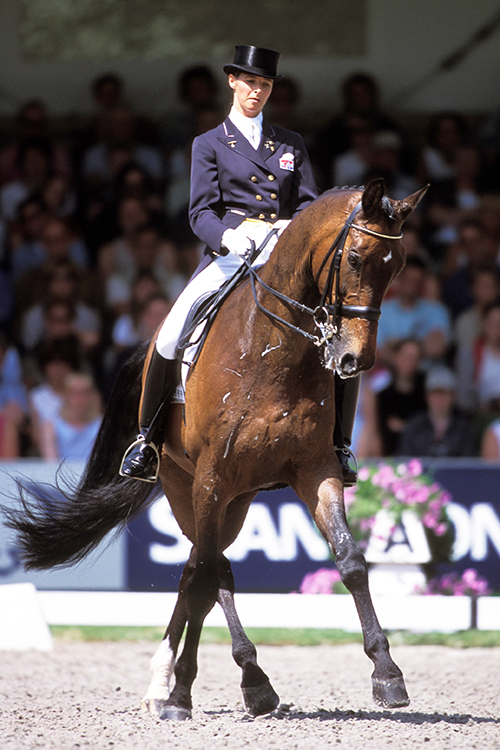
Gonnelien and Leonardo da Vinci
Gonnelien, what was the very beautiful one you had, that was very very hot…
“Leonardo da Vinci, he was great but by the time we understood him, he was too old. We learnt with him that he had to go in a paddock – I rang my Dad and I said, it can be that he will break his leg or whatever, but this risk I take now because I think he is an amazing horse and after he has had a few hours outside by himself, he will be better, more confident in his head. We did it, and it worked perfectly. Then we started to say, ALL horses go outside, when we saw the difference when he went outside.”
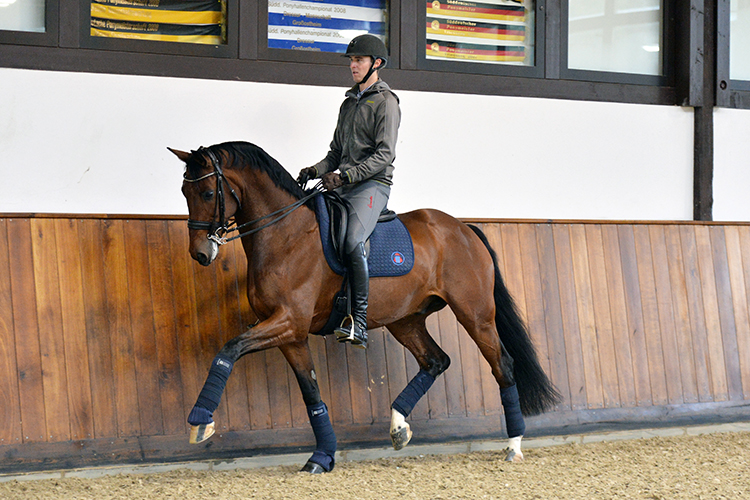
Zgander and Sönke
“Zgander is a special horse,” says Sven, “from the first step you can see he is there, he wants to work, he is waiting in the stable to work. He was a champion in Sweden but he was difficult to ride, we tried it with him as a stallion but we gelded him. It is nicer for him, when he is old he can go with friends in the field, poor stallions, they don’t have such a great life after sport. We collected some semen, so if we think he is the best horse for us, then one day we can breed a mare to him. Honestly, our experience is sport and breeding at the same time, you lose some part of the sport or some part of the breeding, you will always be in between. Perhaps a few stallions like Donnerhall, who have a character that when you saw him breeding it was like, okay I can do it. But there are other stallions who want to do it and then it is difficult, on the shows, everywhere.”
“We haven’t been competing Zgander. We sat together when he was six years old and said, we take four years and in that time, we don’t talk about shows. Sometimes Sönke will take him to a show, but just for training.”
“He is not spooky at all,” says Gonnelien, “That is not the problem, it’s his motivation, I want to go, I want to go… We don’t go to shows because we want to win the golden ribbon, the work with the horses at home is the nicest part.”
Sven’s turn: “When we go to a show and they give us a mark, it is what they think of the work we did at home and at the moment, we don’t feel Zgander is in a position to show all his abilities. They will say he is a bit too nervous, he needs to be more relaxed – until we have the feeling at home of 95%, why go to the show? You can’t get rich by competing dressage, you don’t win big money, so why go there?”
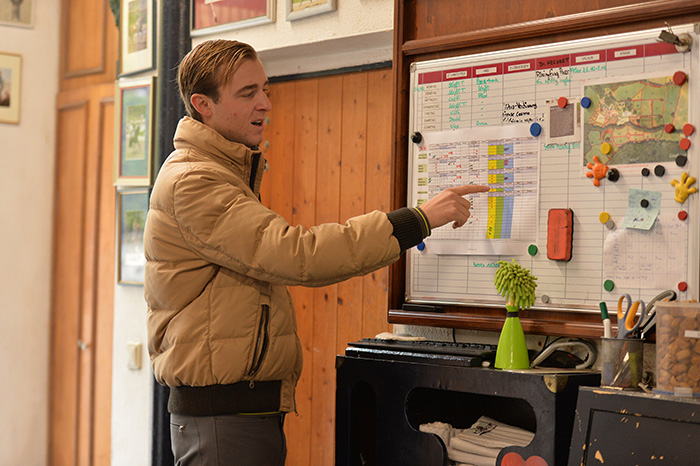
Sönke shows us Gonnelien’s day chart of the day for each horse: work, paddock time, walking outside.
“For our horses, we can take the decisions,” Gonnelien stresses, “Some people help us with sponsorship, but we are in the driver’s seat. If we are entered in a competition and we feel something is not right, we cancel. This freedom we want to have always, the freedom to say, no we stay at home and it doesn’t matter what people say. Cosmo has no shows now, he is not competing in the winter, he is nine, we want to take care of him, we want him for two more Olympics…”
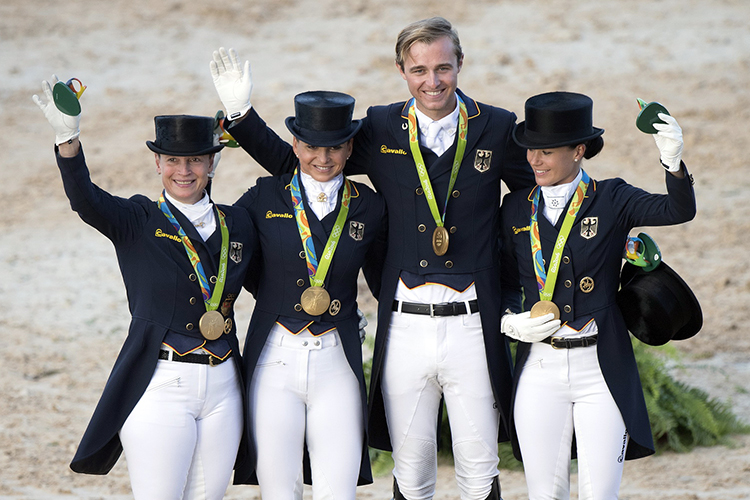
Gold medal team members – youngest rider on the youngest horse, Sönke and Cosmo
Sven agrees: “We could have taken him to Stuttgart, or Lyon, whatever, but the thing is, everyone said, the youngest horse with the youngest rider… with every horse there is one day he is lame or one day he is sick, and then everyone will say, that’s because you competed him when he was nine years old. The Olympics were his 21st show in his life, but he went to perhaps thirty-five shows with us, but just for training, not for competing or showing.”
Sven has turned his gaze back to Zgander and Sönke working in the arena:
“I think he is a special horse, he has a very good walk, and trot and canter, he is always uphill, he learns everything and he has a very good talent for piaffe / passage. We have started a little of that, but only in-hand, we separate it from the riding.”
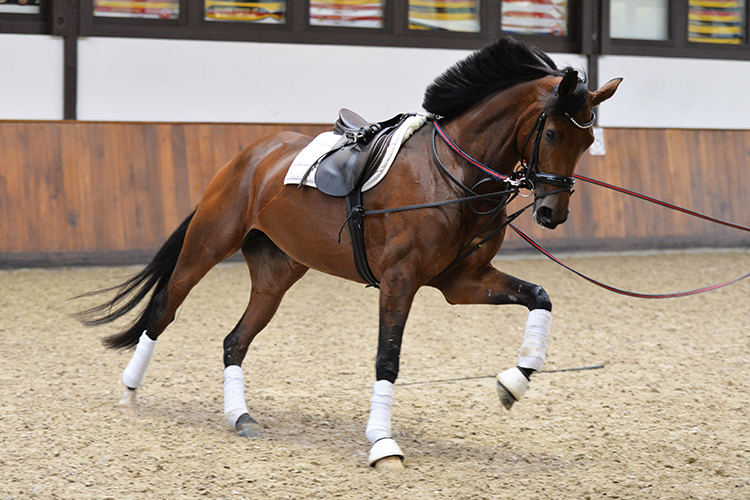
Who taught you the in-hand work?
“What I did today with Hilary, you can criticize a lot, because I had side reins and I put the lunge line through the top band. Honestly I started this way with her because I wanted to be as near as possible to how the rider would give the aids later on because when I tried to ride this horse, three months ago, if I tell you it was impossible, it was impossible – I was faster down than up. I was sweating, not because of working, but because of fear and not knowing what to do.”
“I said I have to be as near on the lunge as I will be in the saddle, so this is just for her, but with other horses that I have more under control, I would go with the lunge line behind the horse – with her, I put the rein across the saddle at the moment because if she kicks out or something and the rein is behind, then she gets it on the mouth and that is the last thing I want to do. Never ever should you put stress on the mouth.”
It fits in with the program of inviting in outside experts, as Gonnelien explains:
“We really want to learn from all people and we like the way Andreas Hausberger works – we saw it on Facebook, and thought how nice, the way he did it and then we asked him, can you come over to our place to show us what you do? I tell you it is really amazing how he does it.”
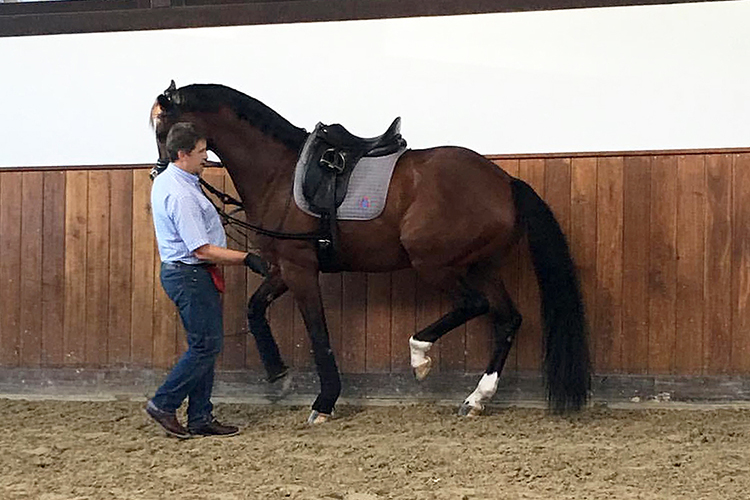
Andreas Hausberger works with Cosmo
While Sven is getting enthused by Sönke’s work in the arena:
“Now he is getting more contact but it is still easy and nice with his hands in the frame. This is what we really like with this horse, you never feel that the work is too much for him, he wants to work, he doesn’t have to kick him or pull him. You see the horse is still a little bit tense. Honestly if someone says we stressed this horse – no, you should have seen him when we got him. He is now 150% better than he was when we got him. We couldn’t have bought him if he hadn’t been that stressed horse. Okay it is not perfect how he goes with Sönke, but it is very good when you see how far he has come.”
“I think our children can be happy that we had our difficult horses in the past like Olympic Bo, she was not easy, and Leonardo da Vinci, so we can sometimes tell our children, less work is better work, we shouldn’t always think we did a good thing by training, training, training, sometimes less is more.”
“Something comes from heaven when you work in a good way to a horse and the horse gets confident. But that doesn’t mean you have to always give him sugar, you have to tell him the boundaries. Daily work, not five days hard and three days off because you have a bad feeling.”
more follows
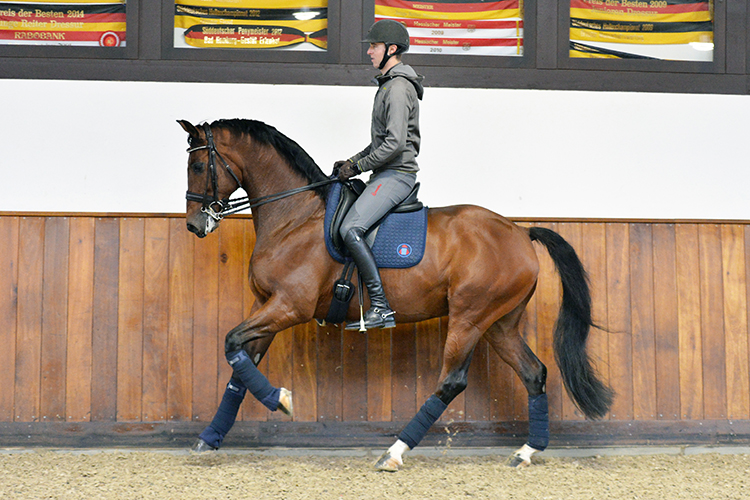
Gonnelien has to deal with it with her students: “One day they come to our barn in a very good mood because they got high marks at school, or they have a new boyfriend, then the next day they are sad because of something – and you see it in their riding. These poor horses, we always tell our children, when you don’t feel right, don’t ride, don’t sit on your horse. The horse is waiting twenty three hours for you and he doesn’t deserve it that you are in a bad mood… lunge the horse, or take him for a walk. Everyone gets stressed, but don’t ride, groom him, that’s also nice.”
Sven is still focused on Sönke and Zgander whose canter is starting to relax: “You can see it is a sensational canter but when you get him to the point where you can push him more, it will improve two marks, I am sure. First of all he has to get control and that the horse accepts his leg. He is still not able to really touch the horse with his leg but he is getting better and better and better, but the quality is there. I love this horse. This is Sönke’s new project. He told me, that even when the horse was difficult, it was a pleasure each day to ride him.”
Although Sven and Gonnelien are justifiably proud of the equestrian success of their talented threesome, they are intent that they learn more about life than just horses. Sven again:
“Our children can start being professional riders, they can try to earn their money with horses, but I want for them that they always have the chance to do something else. I’ve seen more people going down in the sport than going up, because you are dependent on sponsors and good horses, and it is difficult to organize all that. That’s why we are happy that Sanneke has finished her Masters in real estate for an international company. Hopefully, one day she is going to sponsor me.”
How did you come to live on this amazingly beautiful place?
“Just after Gonnelien and I married, we were looking for a place to rent somewhere outside the town (Frankfurt) because we like to be in the country with our horses. I grew up less than 500 metres from here, and in those days, this farm had a small cottage in the forest. The man who rented this place died in 1992 and I contacted the owner, but he said he wanted to sell the whole property. I explained this to my father, and he said, come let’s drive around. My father had some properties where he thought we could build, and I said, why don’t we sell all that and take this farm as a family. One house for my sister, one house for my other sister, think about that… and I have to be really happy that it worked. We moved in, in 1993, and we have been here for twenty three years.”
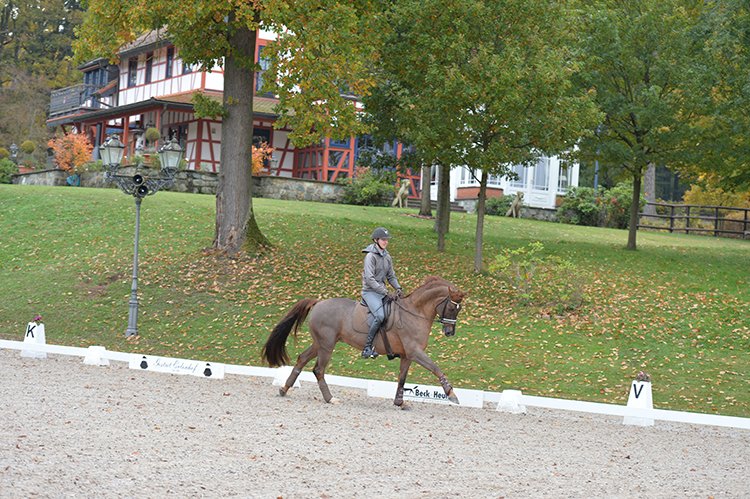
It was a famous Thoroughbred stud…
“It was. Some of the great stallions, Neckar, Ticino were here. They bred eleven German Derby winners, it was a really successful Thoroughbred farm. There on the wall is Nereide, the great grandmother of Weyden who I competed in 1996 at Atlanta. Nereide is on the dam line of Western Star, the sire of Weyden. She held for 30 years the best time in the Derby. Things come together.”
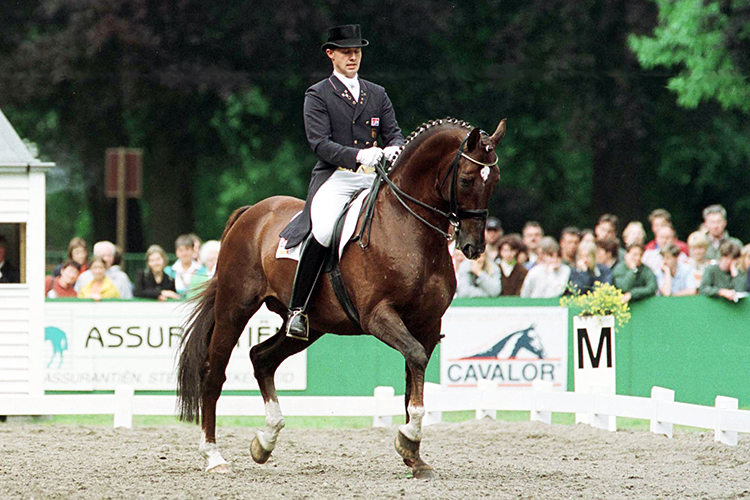
Sven Rothenberger with Weyden
You have students coming here?
“This is more my wife’s area but I really want to swap this across to Sönke and Sanni, that they do it. After these Olympic Games where one of our kids won this gold medal for me it was a very big relief. We have reached now a special point, before it was a lot of effort to get there. When the kids started, we had to give them a lot, and now I think our kids have to be a little bit independent. Sanni is now such a good rider, and Sönke is such a good rider, we have to help more Semmieke. It will be interesting to see what happens in the future, how they combine their jobs with the horses.”
“I like to teach sometimes, but I have to do my job so we can afford to run this farm. I work in real estate in the family business. I don’t find the time to go with the kids to the show, and teach people. I also like to judge, and you need time to do this. Today is a vacation for me to have the time for you.”
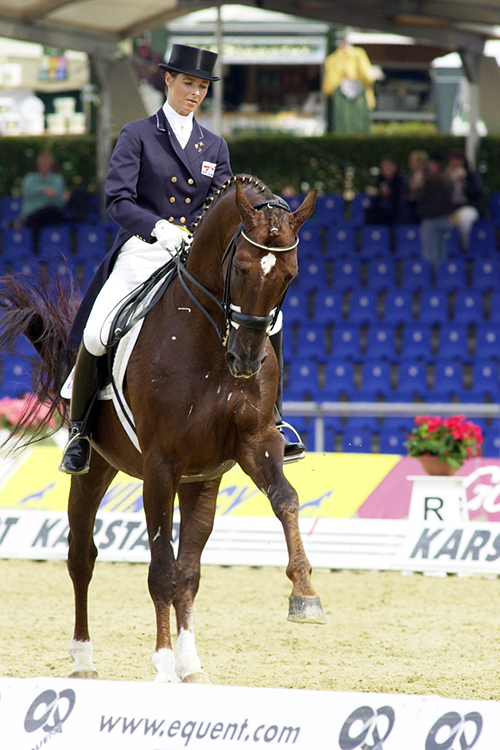
Gonnelien Rothenberger and Weyden
If Sven feels like taking the foot off the pedal a little now that one of the family has a gold medal, it is not a sentiment that Gonnelien shares…
“For me a gold medal is special, the Olympics is special, and it was amazing to be in Rio – but for me it is not, okay, we have the medal so the pressure goes away, no. Cosmo is only nine years old and I think he’s a very very special horse and we are still improving with him. To win a gold medal was amazing, but we want more here, more supple here, there is still improvement. It is like when our children came back from the European Championships, they had won 46 medals! Someone said, that’s amazing, and I said, I never counted them. We work with them all the time here, then go to the Championships, ooh, another gold medal. It’s the work here at home that is important.”
“At home we are talking all the time about horses. You see it in my house, pictures everywhere of horses, and I feel so proud to have this. I loved Sven because I found somebody who really talked the same language about horses – amazing. Then the children are the same, this is the nice thing, and then you get medals because the judges see that it is super nice, they see the harmony. We don’t only ride it, we live it, it is our passion. When I can’t ride my life is over.”
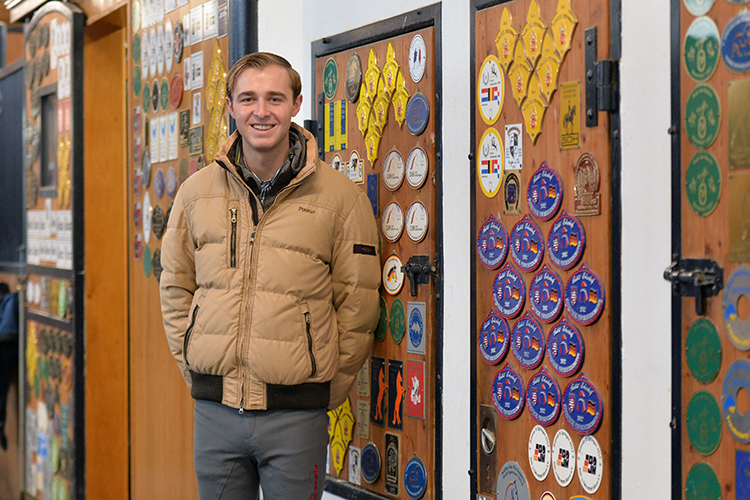
Time out to go and see Sönke and Favorit, on a wonderful outdoor arena, complete with scary judges’ boxes: “I did this when the kids had their ponies,” Sven tells me. “We came to a show and it was, oh, there are flags, oh there are boxes and flowers… I said, okay we make at home everything we find at the show, so they get used to it.”
Roz and I had just come from Holland where Johan Hamminga told me he was doing a clinic with Sven:
“We want to refresh the classical training scale in the education of the dressage horse. That means riding from behind to the hand, riding in a nice frame, and getting the horses independent from your hand. It is important to give this message again and again. I really respect Johan Hamminga because he is not in the front picture of the Dutch trainers…”
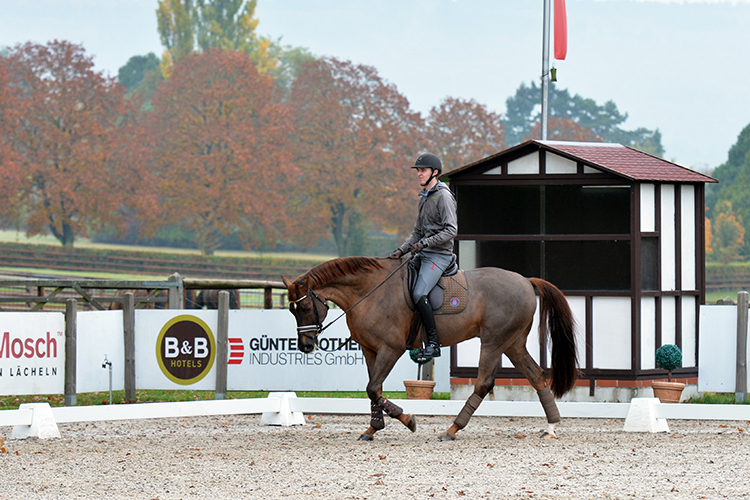
But he should be…
“He has so much experience. He knows how a stallion is when he is young. He knows how a young horse develops, young horses change and you need experience to work with them. I am looking forward to working with him.”
Back down on the arena, Sönke is on another of his Grand Prix horses Favorit, breezing abound the arena.
“He got that a bit from his days as a jumping rider, hacking them along, to keep the horses also thinking, not always doing the tricks. Look at his ears, he is waiting because he is moving.”
And sure enough, Gonnelien is back in trainer mode, the first voice we heard from the corner of the indoor when we arrived, it opens and closes our visit:
“I learnt first as a pony child from Jan Peeters, the judge, so it was correct from the start. Then for a long time I was with Henk van Bergen. This was a very nice time, he’s a little bit the same as Johan Hamminga. When I was with Henk van Bergen, I also traveled to Bert Rutten, because my dad always told me, you can learn from everybody. You can’t say, this is the way, because you are not Henk van Bergen, you are not Johan Hamminga, or Jan Peeters, I have to see what fits to me.”
“Then because Germany won everything, when I told my dad I don’t want to study, I want to ride – then you have to go to Germany because they are best. So I went to train with Conrad Schumacher, he was really famous for teaching young riders. I had a great time, and I met Sven.”
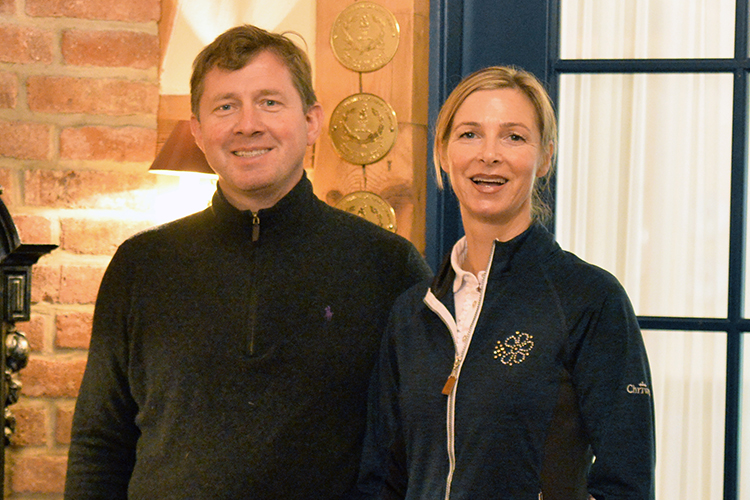
You rode on the Dutch team, were you ever tempted by rolkur?
“I saw it when Anky starts with it, but when I saw her riding, I thought, how is it possible that she gets the head up again? But when I watched her in the competition arena, she gets it, the head is up and in the show, it looks good… but no, I can’t, I didn’t try it. I always learnt to ride from the back to the front and I didn’t want to change that. I saw a few people who started to change, people who had been successful before, they tried and they didn’t understand the system, and they really fell apart and stopped with riding.”
“Sönke was there for one year when he was studying n Holland, and I like it very much that he did it – but never once did Anky ask him to do rolkur. Anky and Sjef are really horse-people, they have their way of riding, and we have another way.”
You ride still?
“I ride but not competing. My daughter is away on a business trip so I could ride all day, but I like it that Sven is here, and gives me lessons. I don’t want to ride like an old woman, it has to be looking nice. I help Sven and he helps me…’
“I try to help her, and I can’t but she really helps me.”
And so it goes, the seemingly endless and ongoing equestrian discussion at the home of the Rothenbergers – I can only imagine what it must be like when you add to the two girls into this heady mix…
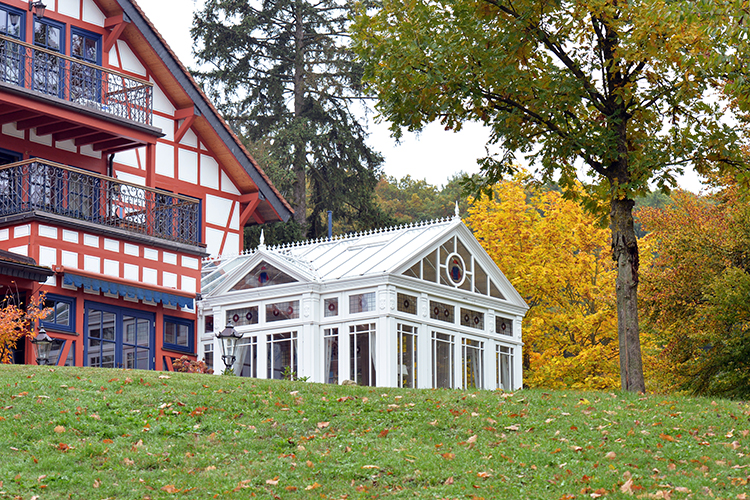
Cosmo Gallery
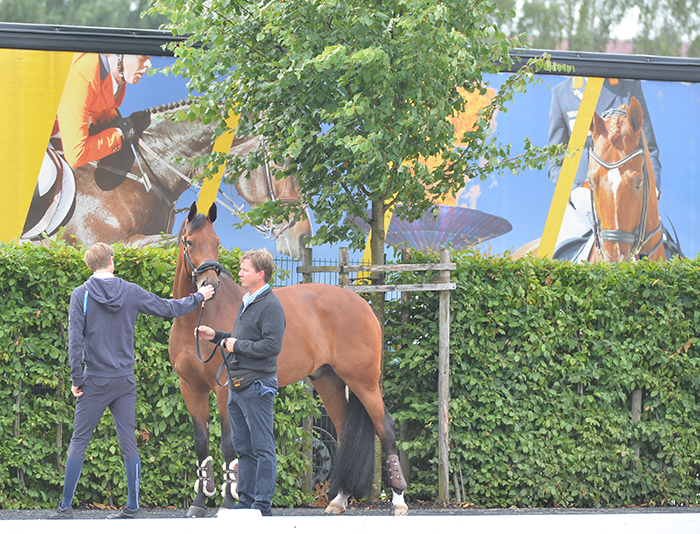
Sven and Sönke take Cosmo for a walk around the Aachen warm-up area before the show starts
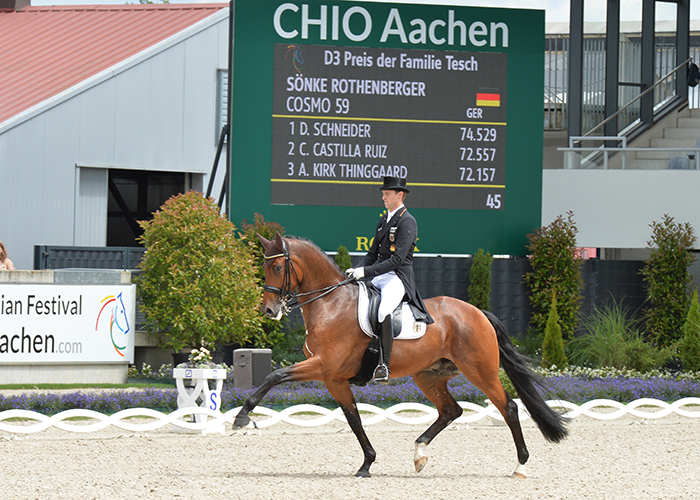
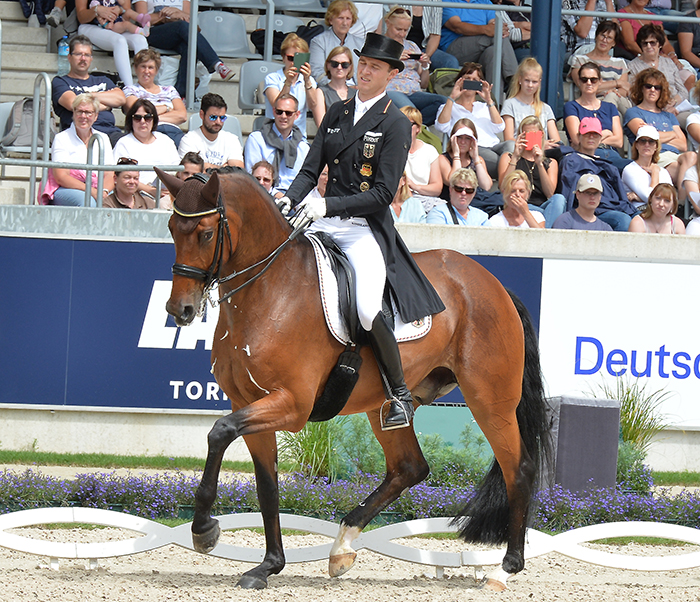
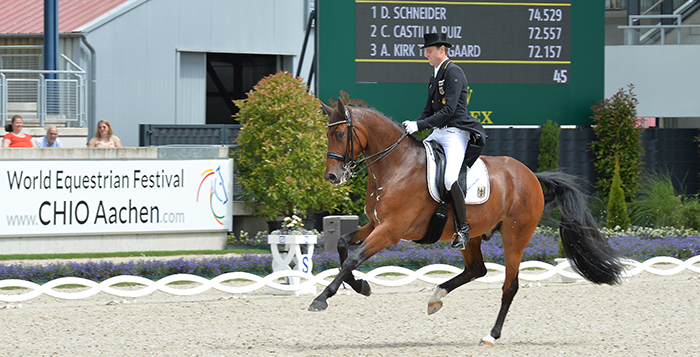
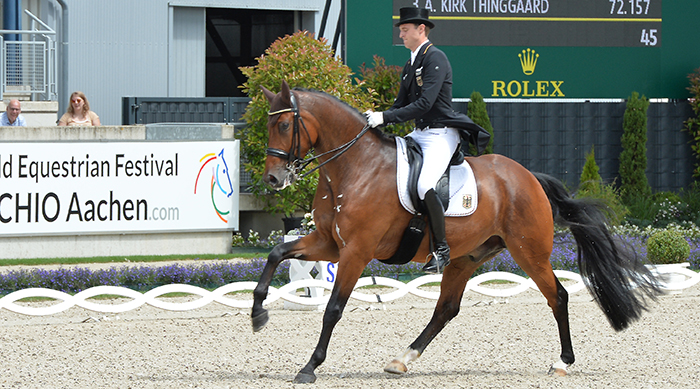
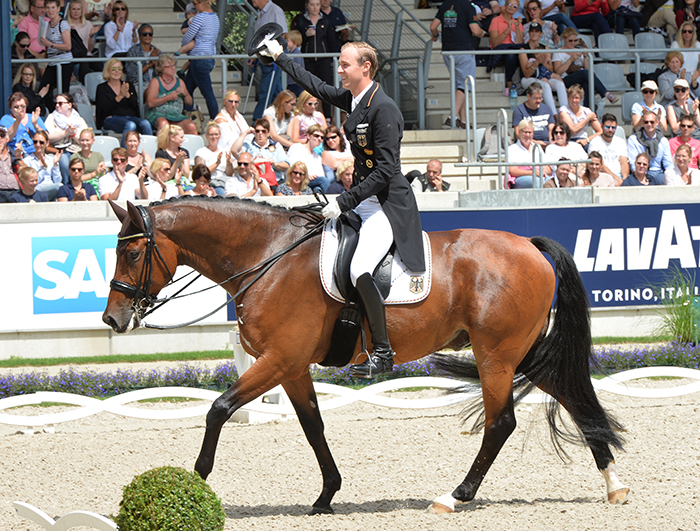
You might also like:

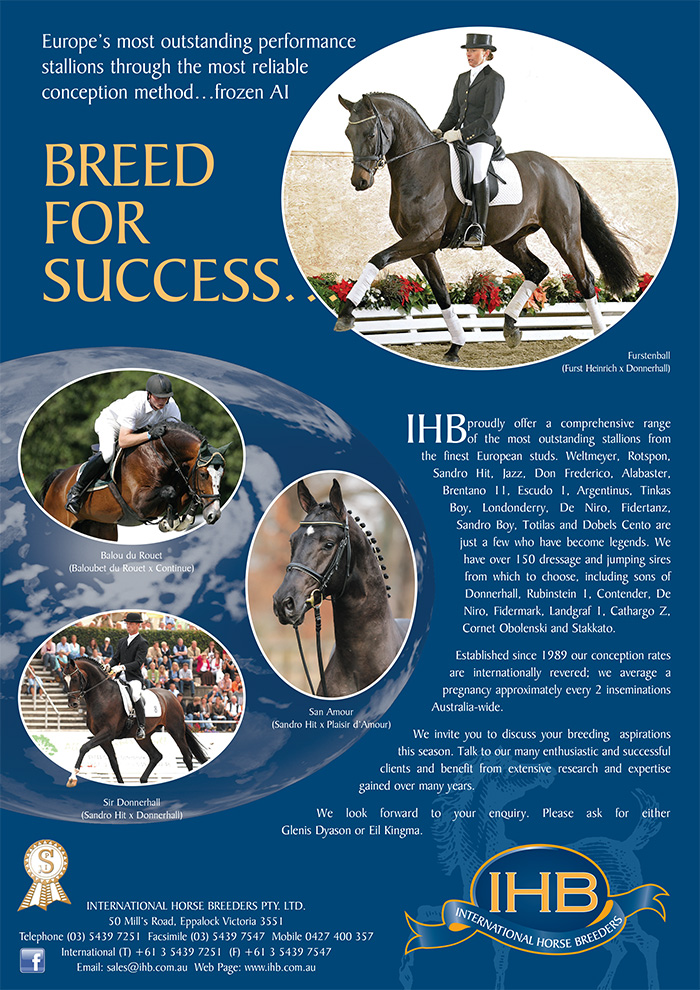
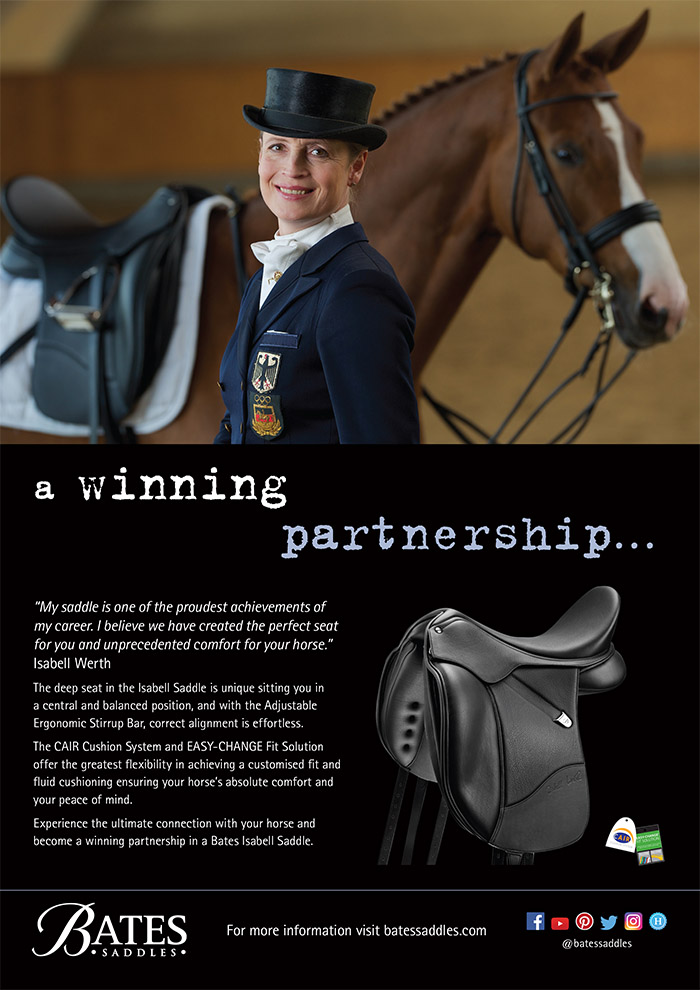
Fascinating – lucky horses and lovely pictures too
A real insight into the behind the scenes work that goes into the horses training. Wonderful article, and magnificent photos of these beautiful and majestic animals.
Great article.
Fabulous insightful article.
I saw Sven ride in Stockholm at WEG in 1990. Even shared a lift with him in the hotel we all stayed at on the Horse Magazine tour !!
So fabulous that all that knowledge and experience is passed on to the younger generation.
The Rothenbergers are such an incredibly lovely family😊.
I worked for them for a while back in 2005/2006 and it was so inspiring to see how committed the whole family is to the welfare and happiness of their horses. Such a professional setup in every aspect. Their attention to detail is exceptional, nothing is overseen or ignored when it comes to the care and training of their horses.
Very interesting and informative article especially into the training of young horses and keeping them active and interested lovely to know that they are all different yet the same. Thank you
A great article that makes for very enjoyable reading. Well done Chris Hector for asking such pertinent questions. The value of working in hand and teaching horses ground skills cannot be underestimated. Horses will always be your best teacher.
I loved this article. Very refreshing to read about the training, management of their horses and love the Rothenberger Family have for them. It made me feel warm inside to know that somewhere in the World the training and care of sport horses is being done in the correct way.
Awesome story! Didn’t Sven buy the first horse to represent Australia in Olympic dressage, Dondolo (Barcelona ’92, rider Christine Down). It would be interesting to know what happened to him.
I don’t know where Dondolo ended up, but he wasn’t the first Australian Olympic dressage representative. If you count the alternative Games in 1980, when Australia boycotted Moscow, Judy Mackay was the first with Debonaire, Margaret McIvor rode CK four years later at Los Angeles, and Erica Taylor rode Crown Lawn at the 1988 Games in Seoul. CH